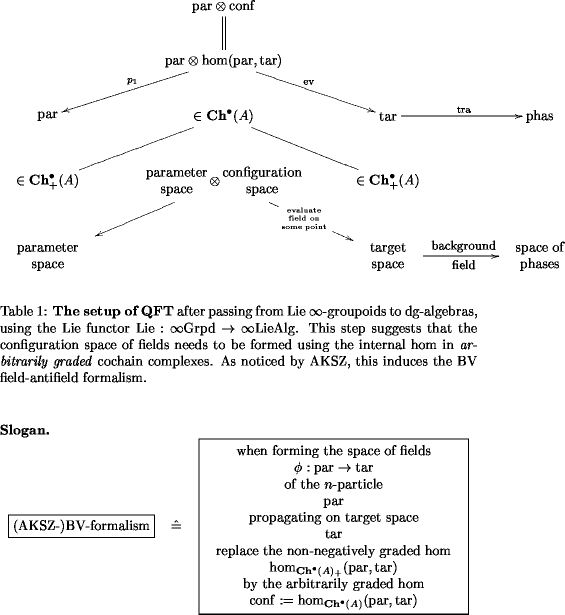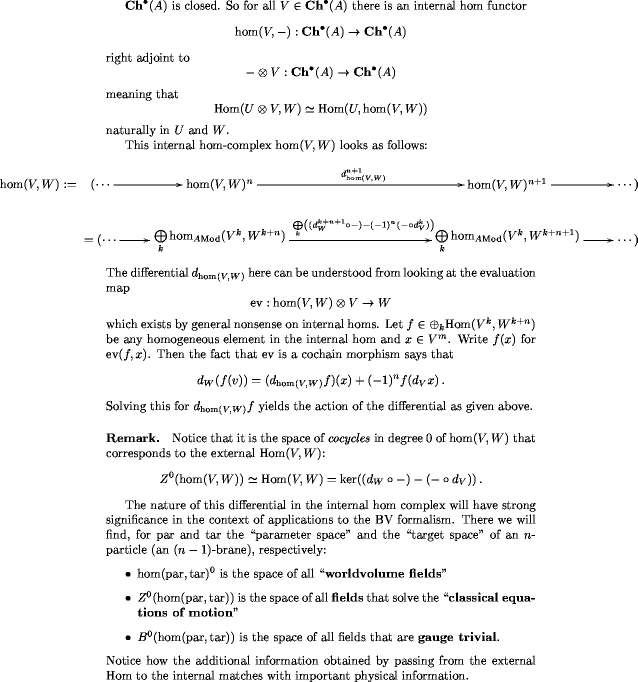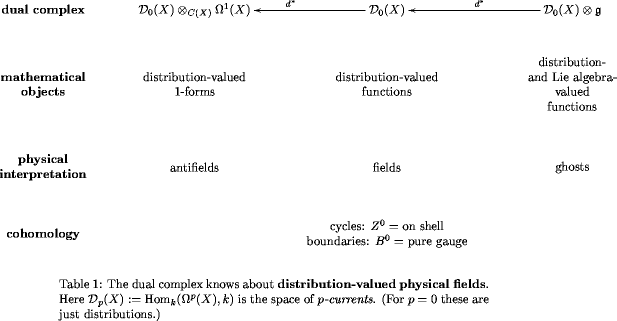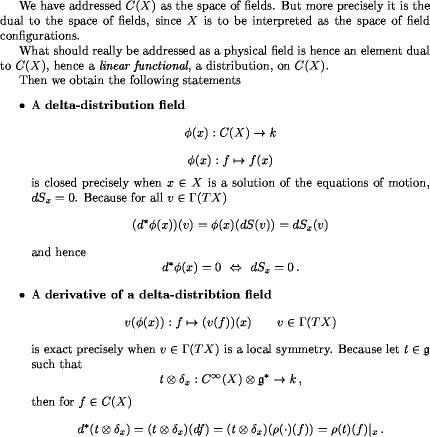On BV Quantization, Part VIII
Posted by Urs Schreiber
A good way to understand the relevance and meaning of the trinity of
in the BV-formulation of quantum field theory (part I, II, III, IV, V, VI, VII) is to interpret the story of the charged -particle in the world of Lie -algebroids (as opposed to Lie -groupoids), which have a restriction on the sign of the degrees of their morphisms, but then form the configuration space of fields by taking the internal hom in the category of arbitrarily graded things.ghosts – fields – anti-fields
This is, to my mind, how to interpret one of the crucial points of AKSZ: The Geometry of the Master Equation and Topological Quantum Field Theory.
Here I start to talk about that, but it will probably take me more than one installment. Progress will be documented in On Lie -modules and the BV complex.
Recall, maybe from QFT of the Charged -Particle: Definition, that quantum (field) theory is the study of the following setup:
- a Lie -category , called the parameter space or the -particle
- a Lie -category , called the target space
- an -functor called the background field
(and possibly a symplectic structure on some of the -groupoids, but this will be the topic of later installments)
which allows to form the configuration space
The background field transgresses to this configuration space, where it then forms the (non-kinetic part of) the action of the -particle.
In practice, instead of Lie -groupoids one will often turn to the corresponding Lie -algebroids (see for instance On Lie -tegration and Rational Homotopy Theory).
Depending on various conventions, these are structures on (co)chain complexes of non-negative degree, and that makes good sense:
the stuff in degree are the tangents to the space of -morphisms of the original -groupoid.
But when we forget categories and just look at chain complexes, then there is nothing more natural than allowing arbitrary gradings. This hence corresponds to considering categories with negative morphisms.
Luckily the Wizards have thought of that before. And have come up with a name for them: -categories.
As far as I understand, there are currently precisely two persons on this planet who have seriously thought about -categories: John Baez and Jim Dolan. Though the point is that in disguise at least -groupoids are well known to topologists: -groupoids correspond to spectra.
But let’s not worry about -categories too much at this point. While they nicely highlight the depth of the step from non-negative to arbitrary grading, performing that step itself in the linearized world of complexes and dg-algebras is very simple. (Maybe too simple, actually. Nobody seems to discuss the deep importance of this simple step.)
Then we obtain a picture of this sort:

I have tried to summarize some of the properties of the category of (co)chain complexes that we need in section 2.

So before actually going in to the AKSZ description of the charged -particle, let’s have another look at our toy example setup from BV for Dummies and On Noether’s Second (BV, Part VI).
Recall that there we were dealing with a setup where
- configuration space
is an ordinary manifold, and where the action
-
is an ordinary function on that manifold.
This induced for us the BV-complex which was a dg-algebra extension of this simple situation
(Here the denotes the result of restricting domain and codomain of to be (i.e. just the first tensor power). )
(which I have taken from Modules for Lie -Algebras).
In order to fully appreciate the AKSZ-BV construction for the charged quantum -particle, we need to familiarize ourselves with the dual picture of this BV complex (section 4.3.5):

By simply working out what the dual differential is, one finds

With that simple example in mind, we should now see what happens when we form the configuration space of worldvolume fields of the charged -particle using the internal hom in arbitrarily graded chain complexes.
But this I’ll discuss next time.

Re: On BV Quantization, Part VIII
Cool stuff! You are clearly becoming quite a WizardTM yourself.
One pathetically minor question: when you write
what’s the meaning of that little asterisk? It doesn’t mean ‘dual’, does it? Is it hinting at a footnote I can’t find??